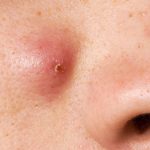 A pathologic cavity lined by epithelium and usually containing fluid or semi‐solid material.
A pathologic cavity lined by epithelium and usually containing fluid or semi‐solid material.
A membrane-enclosed sac containing fluid, pus, or other soft material that develops as an abnormal growth. Cysts can develop just under the skin (so-called epidermal cysts) or inside the body in organs such as the ovaries or kidneys.
A closed cavity or sac that contains liquid or semiliquid material.
An unusual growth in the body shaped like a pouch, containing liquid or semiliquid substances.
Closed, fluid-filled sac embedded in tissue (as in the breast) that is abnormal or results from disease.
A small, closed sac filled with liquid, semisolid, or solid material. A cyst can become inflamed, infected, and painful. If cysts become infected or are otherwise troublesome, they can be removed through draining or excision (cutting).
An abnormal sac or closed cavity lined with epithelium and filled with liquid or semisolid matter. There are many varieties of cysts occurring in different parts of the body. Retention cysts arise when the outlet of a glandular duct is blocked, as in sebaceous cysts. Some cysts are congenital, due to abnormal embryonic development; for example, dermoid cysts. Others are tumors containing cells that secrete mucus or other substances, and another type of cyst is formed by parasites in the body.
Closed, abnormally developed sac that contains fluid, pus, semifluid, or morbid matter above or below the skin.
